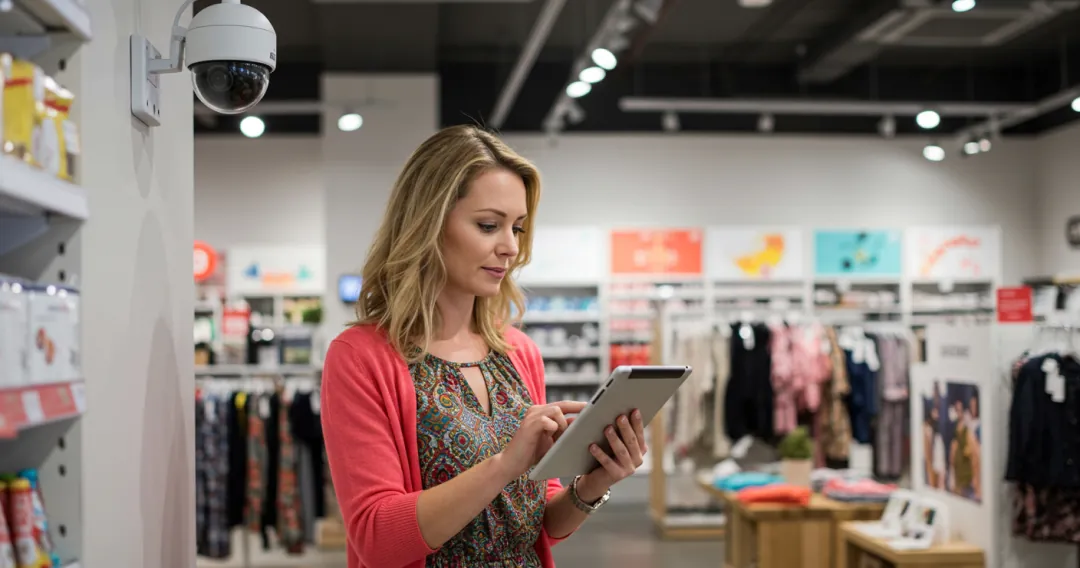Key Takeaways:
-
- The retail loss detection market is segmented into mechanical, electronics, and camera surveillance solutions, each addressing specific threats.
- Applications include shoplifting prevention, employee theft detection, and broader fraud and supply chain security measures.
- Emerging technologies like AI-powered video surveillance and RFID tracking are transforming loss detection strategies.
- A comprehensive approach combining technology, employee training, and data analysis ensures effective loss prevention.
Market Segmentation: Types of Retail Loss Detection Solutions
The retail loss detection market is categorized into three main solution types: mechanical, electronics, and camera surveillance solutions. Each offers unique benefits tailored to specific challenges.
Mechanical Solutions
Traditional mechanical security systems such as locks, barriers, and tethering devices provide a foundational layer of protection. These systems physically restrict access to merchandise, deterring theft through visible barriers. For example, high-value items like electronics are often tethered to displays using recoilers or locked into secure display mounts.
Electronics Solutions
Electronic security devices add a technological layer to loss detection. Tools like electronic article surveillance (EAS) tags trigger alarms when merchandise is removed without proper deactivation at checkout. Alarm systems and access control solutions also fall under this category, helping retailers monitor entry points and prevent unauthorized access to sensitive areas.
Camera Surveillance Solutions
Video surveillance systems equipped with AI capabilities are pivotal in modern retail loss detection. High-resolution cameras monitor store activity in real-time, identifying suspicious behaviors such as loitering or concealing items. Advanced features like facial recognition and anomaly detection further enhance these systems’ effectiveness in preventing theft and fraud.
Other Emerging Technologies
This category includes innovative tools like RFID tracking for real-time inventory management, biometric identification for access control, and cloud-based analytics for fraud detection. These technologies provide retailers with actionable insights to address vulnerabilities across their operations.
Applications of Retail Loss Detection
The market’s applications target specific threats retailers face daily:
Shoplifting Prevention
Shoplifting remains one of the most significant sources of retail shrinkage. Technologies such as EAS tags, AI-powered video analytics, and POS monitoring help detect theft attempts in real time. By identifying suspicious behaviors like prolonged loitering or unusual item handling, these solutions enable swift intervention.
Employee Theft Detection
Internal theft is another critical concern for retailers. Measures such as access controls, employee monitoring systems, and inventory tracking help mitigate risks posed by dishonest staff members. For example, AI-powered cameras can detect unauthorized discounts or “sweethearting” (collusion between employees and customers).
Broader Applications
Beyond shoplifting and employee theft, retail loss detection extends to fraud prevention (e.g., counterfeit returns), supply chain security (e.g., monitoring product movement), cash management systems (e.g., detecting discrepancies), and cybersecurity measures to protect sensitive customer data.

Leveraging Technology for Effective Loss Detection
Technology plays a transformative role in modern retail loss detection strategies:
-
- AI-Powered Video Surveillance: AI algorithms analyze shopper behavior to detect anomalies like loitering or item concealment. Real-time alerts allow staff to intervene before losses occur.
- AI-Powered Video Surveillance: AI algorithms analyze shopper behavior to detect anomalies like loitering or item concealment. Real-time alerts allow staff to intervene before losses occur.
-
- RFID Tracking: Radio-frequency identification enables precise tracking of inventory throughout the supply chain, reducing errors and improving stock visibility.
- RFID Tracking: Radio-frequency identification enables precise tracking of inventory throughout the supply chain, reducing errors and improving stock visibility.
-
- Exception-Based Reporting (EBR): EBR systems flag irregularities in transactions—such as excessive discounts or voided sales—allowing managers to investigate potential fraud or errors.
By integrating these technologies into their operations, retailers can gain deeper insights into loss patterns while improving response times.
The Role of Employee Training
While technology is essential for detecting losses, employees remain a critical line of defense. Proper training equips staff with the skills needed to recognize suspicious behavior, follow established protocols for handling cash or returns, and report concerns promptly. Additionally, providing excellent customer service can deter theft by creating an engaged store environment where suspicious activities are harder to conceal.
ThinkLP’s Contribution to Retail Loss Detection
ThinkLP offers a centralized platform that empowers retailers to manage all aspects of loss prevention more effectively. By consolidating data from multiple sources—such as POS systems, video surveillance tools, and incident reports—ThinkLP provides actionable insights that help identify trends and vulnerabilities. Its analytics capabilities enable retailers to make informed decisions about where to focus their efforts while streamlining workflows for incident investigation and resolution.
Building a Comprehensive Loss Detection Strategy
A successful retail loss detection strategy combines technology with proactive measures:
1. Risk Assessment: Identify high-risk areas within your operations—whether they involve specific products, store locations, or staff roles—and prioritize them for intervention.
2 .Layered Security: Use a combination of mechanical barriers (e.g., locks), electronic tools (e.g., EAS tags), and advanced technologies (e.g., AI cameras) for comprehensive protection.
3. Data-Driven Insights: Leverage analytics platforms like ThinkLP to monitor performance metrics such as shrinkage rates or flagged transactions.
4. Employee Engagement: Train staff regularly on best practices for preventing losses while fostering a culture that values accountability.
Final Thoughts
Retail loss detection is an essential component of any retailer’s strategy for maintaining profitability and operational efficiency. As the market continues to grow—with innovations like AI-powered surveillance and RFID tracking leading the way—retailers must adopt comprehensive approaches that address both external threats like shoplifting and internal risks such as employee theft. By combining technology with strong policies and employee training programs—and utilizing platforms like ThinkLP—retailers can stay ahead of emerging challenges while protecting their bottom line.
Explore ThinkLP’s Blog
Now that you know about retail loss detection, you can find additional insights on loss prevention and safety intelligence on ThinkLP’s blog. The blog features articles, case studies, and industry insights that provide practical tips and strategies for improving your loss prevention efforts.
Request a Demo
If you are interested in how ThinkLP’s software can support your loss prevention initiatives, we invite you to request a demo. Their Loss & Safety Intelligence Platform is designed to integrate with your existing operations, helping you reduce risks and improve efficiency. Reach out today to learn how ThinkLP can assist your organization in optimizing its loss prevention strategy.


